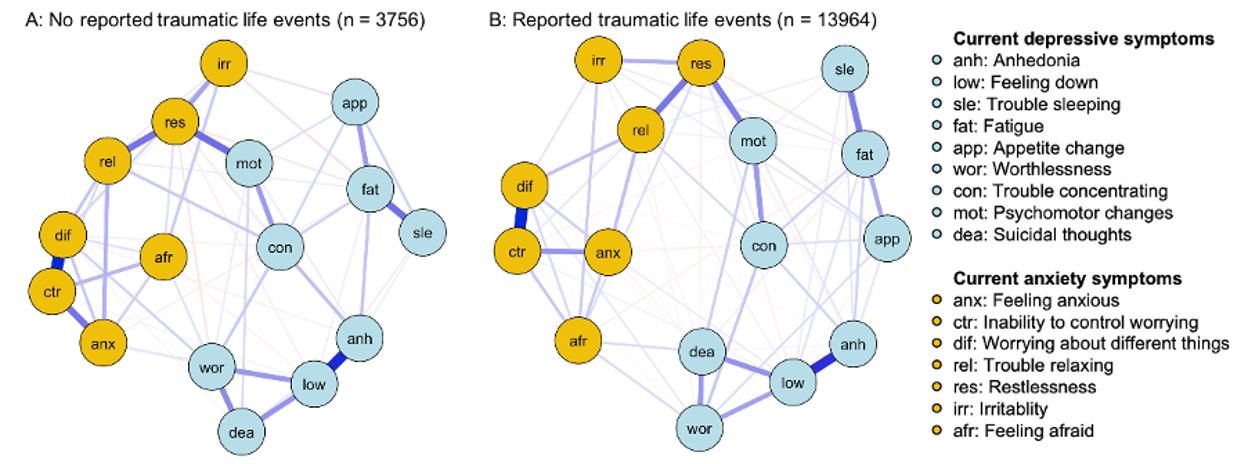EDIT Lab PhD student, Alicia, outlines new research from the GLAD Study, exploring whether the presentation of anxiety and depression is different in individuals who report traumatic life events.
Research has shown that experiencing traumatic life events is associated with an increased risk of developing symptoms of depression and anxiety. These events can occur throughout life, including childhood maltreatment, domestic abuse or major life events, such as being in a serious accident. However, we are uncertain whether these events are associated with experiencing certain symptoms of depression and anxiety.
In our study, published recently in Journal of Affective Disorders Reports, we examined whether reporting traumatic life events has an impact on the presentation of depression and anxiety symptoms. We grouped participants from the Genetic Links to Anxiety and Depression (GLAD) Study into those who did report traumatic life events and those who did not. We then looked at differences in their symptom profiles, which refers to the way symptoms of a disorder connect to each other within an individual, using a technique called network analysis.
Network analysis
In network analysis, depression and anxiety are viewed as networks of symptoms that are all connected. Each symptom is represented as a circle (known as a “node”), and the associations between two symptoms are represented as lines between the nodes (known as “edges”), as in the figure below. Purple edges show a positive association between two symptoms and red edges show negative associations. For example, there is a positive edge between trouble sleeping and fatigue, indicating that as one symptom increases, so does the other. The thicker and darker the edge, the stronger the connection between two symptoms. For example, the association between fatigue and sleep problems is stronger than the association between fatigue and appetite change. In the figure below, symptoms of depression are shown in blue, and symptoms of generalised anxiety are shown in yellow.
 Figure 1. Networks of depression and anxiety symptoms in GLAD Study participants who reported a traumatic life event (on the right) and who did not (on the left).
Figure 1. Networks of depression and anxiety symptoms in GLAD Study participants who reported a traumatic life event (on the right) and who did not (on the left).
Traumatic events in GLAD
Approximately three quarters of GLAD participants reported at least one traumatic life event. Although this figure seems very high, it is roughly what we would expect to see in a group of individuals who have been recruited based on their experience of depression and anxiety.
Traumatic events and symptom profiles
In GLAD, we found that there were no statistically significant differences between the symptom networks of participants who did and did not report any lifetime traumatic events. Both networks showed a similar pattern of associations between symptoms, and these associations were generally of the same strength. This suggests that in GLAD, participants reporting lifetime traumatic events had a similar presentation of anxiety and depressive symptoms as participants who did not report any of these events.
Replication in UK Biobank
We then repeated this study in participants from the UK Biobank, a large general population cohort who weren’t recruited on the basis of having any mental health condition. In this sample, the prevalence of depression and anxiety is roughly the same as in the UK population. In UK Biobank, we found that participants who reported lifetime traumatic events had stronger associations between symptoms of depression and anxiety than those who did not report any traumatic events. This indicates that in participants who reported lifetime traumatic events symptoms are more likely to reinforce one another and may be more persistent.
So why were the findings in UK Biobank different to in GLAD?
We think this may be because in a general population sample like UK Biobank there are likely to be more participants with only mild or no symptoms of depression and anxiety, so we are able to notice bigger differences in presentation between those who did and did not report traumatic life events. In the GLAD Study, all participants have experienced depression or anxiety in their lives, and most have experienced quite severe symptoms. This means there is less variation in participants’ symptoms profiles, and it is harder to see differences between groups. The bigger the GLAD Study gets, the more participants we will be able to include in our analysis and the more power we will have to explore symptom profiles in the future! If you would like to be part of the GLAD Study, visit gladstudy.org.uk to sign up.
Acknowledgments
We gratefully acknowledge the participation of all GLAD Study and UK Biobank volunteers who have made this research possible by sharing their life experiences. We would like to thank all the scientists involved in the construction and management of the GLAD Study and the UK Biobank.
Citation
Peel, A. J., Armour C., Buckman J. E. J., Coleman J. R. I., Curzons S. C. B., Davies M. R., Hübel C., Jones I., Kalsi G., McAtarsney-Kovacs M., McIntosh A. M., Monssen D., Mundy J., Rayner C., Rogers H. C., Skelton M., ter Kuile A., Thompson K. N., Breen G., Danese A.* & Eley* T. C. (2021). Comparison of depression and anxiety symptom networks in reporters and non-reporters of lifetime trauma in two samples of differing severity. Journal of Affective Disorders Reports, 6, 100201. https://doi.org/10.1016/j.jadr.2021.100201

